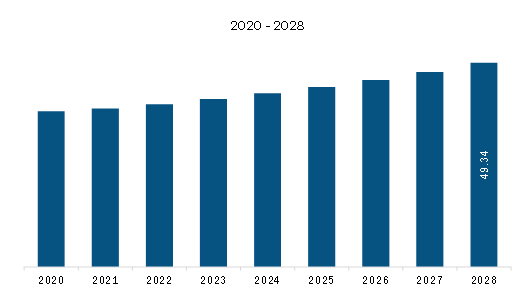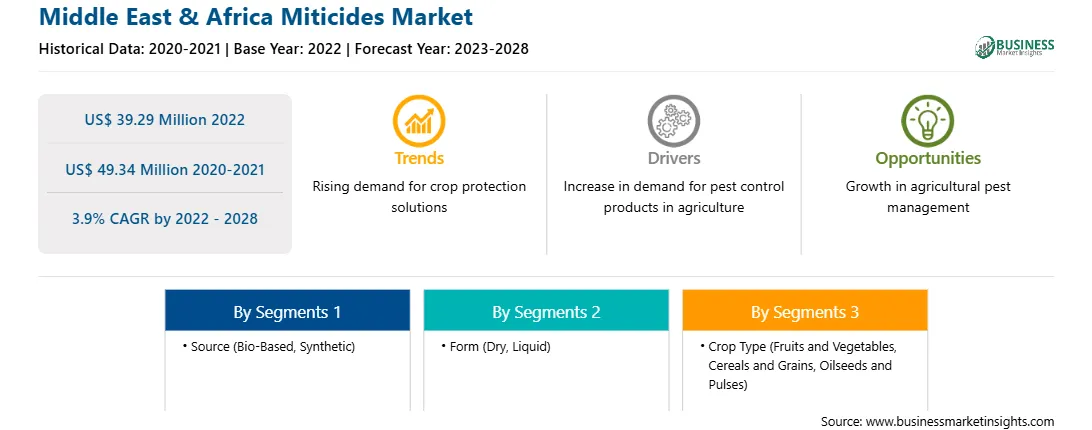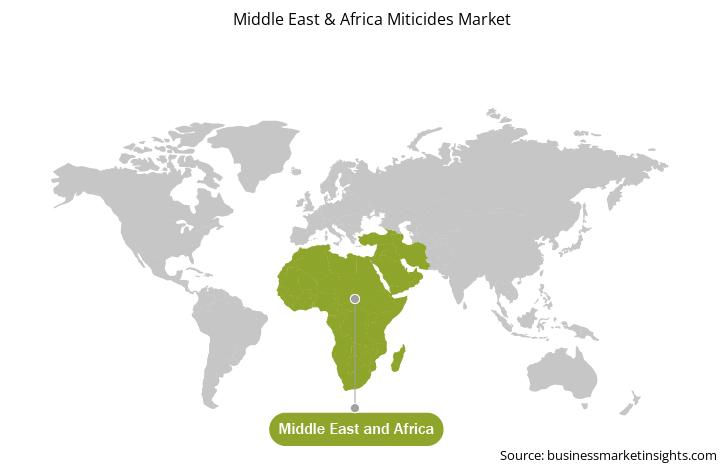A miticide is a chemical insecticide that mainly targets mites (e.g., spider mites) that harbor fruits and vegetables, cereals and grains, oilseeds and pulses, turf and landscape, ornamental flowers, and forage and plantation crops. Miticides are packed in the form of spray concentrates and have powerful active ingredients, resulting in a quick knockdown and fast kill. However, the development of miticide resistance in mites is a major issue in the agriculture field. Repeated pesticide uses result in microevolution due to the selection pressure, ultimately leading to resistance development. Thus, manufacturers have shifted their focus on offering miticides made of chemicals such as omite and palictran, which give better results without harming the predatory fauna of mite pests. Moreover, they offer effective products that can kill mites in all stages of their lifecycle. BASF SE and Sym-Agro, among others, offer organic miticides that also act as fungicides. These miticides help to control adelgids, aphids, fungus gnats, lace bugs, leafminers, leafhoppers, mealybugs, mites, scale, thrips, whiteflies, webworms, and powdery mildew on ornamentals. Such innovative multipurpose products are becoming popular among farmers as they lower the cost of production. Many countries are encouraging the development of pesticides for agricultural use. For instance. Thus, the development of novel products, coupled with favorable government initiatives, is offering future growth opportunities for the Middle East & Africa miticides market players.
The Middle East & Africa faces land and water scarcity issues. Many farmers in developing countries consider pesticide use as the best means to protect their crops against pests, such as desert locusts in parts of the Middle East & Africa, which are often the main threat they face. According to the US Department of Agriculture's Foreign Agricultural Service (USDA FAS), the production of fresh lemons and limes in South Africa is projected to grow by 2% during 2022–2023, bringing it to 660,000 metric tons (MT). Additionally, orange production in Egypt is forecasted to reach 3.6 million metric tons (MMT) during 2022–2023, an increase of almost 20% compared to the production in the prior season that was 3 MMT. These citrus fruits can be largely get affected due to mites, such as citrus rust mites. Thus, to prevent crop damage, the usage of miticides is expected to increase during the forecast period. According to the Food and Agriculture Organization Corporate Statistical Database, Egypt is the world's largest producer of dates, followed by Iran, Algeria, Saudi Arabia, and the UAE. Mite infestation leads to the downgrading of date fruit. In many cases, the fruits may need to be rehydrated to reduce the extent of damage and economic losses. However, the rehydration process can increase the production cost. Thus, the demand for miticides is increasing in the Middle East & Africa.
Strategic insights for the Middle East & Africa Miticides provides data-driven analysis of the industry landscape, including current trends, key players, and regional nuances. These insights offer actionable recommendations, enabling readers to differentiate themselves from competitors by identifying untapped segments or developing unique value propositions. Leveraging data analytics, these insights help industry players anticipate the market shifts, whether investors, manufacturers, or other stakeholders. A future-oriented perspective is essential, helping stakeholders anticipate market shifts and position themselves for long-term success in this dynamic region. Ultimately, effective strategic insights empower readers to make informed decisions that drive profitability and achieve their business objectives within the market. The geographic scope of the Middle East & Africa Miticides refers to the specific areas in which a business operates and competes. Understanding local distinctions, such as diverse consumer preferences (e.g., demand for specific plug types or battery backup durations), varying economic conditions, and regulatory environments, is crucial for tailoring strategies to specific markets. Businesses can expand their reach by identifying underserved areas or adapting their offerings to meet local demands. A clear market focus allows for more effective resource allocation, targeted marketing campaigns, and better positioning against local competitors, ultimately driving growth in those targeted areas.
Middle East & Africa Miticides Strategic Insights

Middle East & Africa Miticides Report Scope
Report Attribute
Details
Market size in 2022
US$ 39.29 Million
Market Size by 2028
US$ 49.34 Million
Global CAGR (2022 - 2028)
3.9%
Historical Data
2020-2021
Forecast period
2023-2028
Segments Covered
By Source
By Form
By Crop Type
Regions and Countries Covered
Middle East and Africa
Market leaders and key company profiles
Middle East & Africa Miticides Regional Insights

Middle East & Africa Miticides Market Segmentation
The Middle East & Africa Miticides market is segmented into source, form, crop type, and country.
Based on source, the Middle East & Africa miticides market is bifurcated into bio-based and synthetic. In 2022, the synthetic segment registered a larger share in the Middle East & Africa miticides market.
Based on form, the Middle East & Africa miticides market is segmented into dry and liquid. In 2022, the liquid segment registered a larger share in the Middle East & Africa miticides market.
Based on crop type, the Middle East & Africa miticides market is segmented into fruits and vegetables, cereals and grains, oilseeds and pulses, and others. In 2022, the fruits and vegetables segment registered a largest share in the Middle East & Africa miticides market.
Based on country, the Middle East & Africa miticides market is segmented South Africa, Saudi Arabia, the UAE, and the Rest of Middle East & Africa. In 2022, the Rest of Middle East & Africa segment registered a largest share in the Middle East & Africa miticides market.
BASF SE; Bayer AG; Certis USA LLC; FMC Corp; Gowan Co; Kemin Industries Inc.; Oro Agri International BV; Syngenta AG; and UPL Ltd are the leading companies operating in the Middle East & Africa miticides market.
The Middle East & Africa Miticides Market is valued at US$ 39.29 Million in 2022, it is projected to reach US$ 49.34 Million by 2028.
As per our report Middle East & Africa Miticides Market, the market size is valued at US$ 39.29 Million in 2022, projecting it to reach US$ 49.34 Million by 2028. This translates to a CAGR of approximately 3.9% during the forecast period.
The Middle East & Africa Miticides Market report typically cover these key segments-
The historic period, base year, and forecast period can vary slightly depending on the specific market research report. However, for the Middle East & Africa Miticides Market report:
The Middle East & Africa Miticides Market is populated by several key players, each contributing to its growth and innovation. Some of the major players include:
The Middle East & Africa Miticides Market report is valuable for diverse stakeholders, including:
Essentially, anyone involved in or considering involvement in the Middle East & Africa Miticides Market value chain can benefit from the information contained in a comprehensive market report.